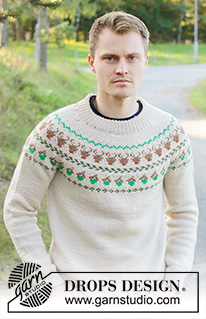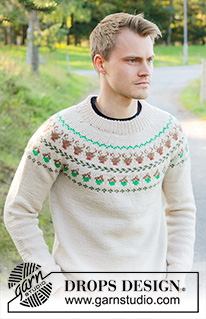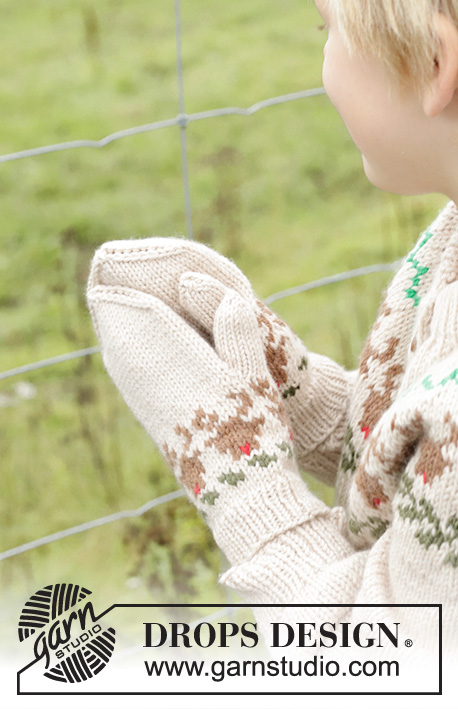Comments / Questions (2)
![]() Rasa wrote:
Rasa wrote:
Can you please explain on increases, we casted on 118 stitches and we need to increase 34 stitches evently spaced, but 118 do not divide from 34. Please help 🙂
25.04.2025 - 20:57DROPS Design answered:
Dear Rasa, even if you can't divide exactly, you will spread them as evenly as possible; you can find more information about this in this lesson. Happy knitting!
26.04.2025 - 20:45
![]() Mo Hooper wrote:
Mo Hooper wrote:
What is the design on row beneath reindeer? I thought it depicts acorns but not sure.
14.12.2024 - 19:47DROPS Design answered:
Hi, yes, they're acorns :-). Happy knitting!
15.12.2024 - 10:19
Reindeer Dance Sweater#reindeerdancesweater |
|||||||||||||||||||
 |
 |
||||||||||||||||||
Knitted jumper for men in DROPS Daisy. The piece is worked top down with double neck, round yoke and multi-coloured reindeer pattern. Sizes S - XXXL.
DROPS 246-42 |
|||||||||||||||||||
|
------------------------------------------------------- EXPLANATIONS FOR THE PATTERN: ------------------------------------------------------- ELEVATION: To make the jumper higher at the back when working a round yoke, work an elevation. Skip this section if you do not want an elevation. Start from the right side and knit 16-17-18-19-20-21 stitches past the marker-thread at the beginning of the round (mid-back), turn, tighten the strand and purl 32-34-36-38-40-42. Turn, tighten the strand and knit 48-51-54-57-60-63, turn, tighten the strand and purl 64-68-72-76-80-84. Turn, tighten the strand and knit 80-85-90-95-100-105, turn, tighten the strand and purl 96-102-108-114-120-126. Turn, tighten the strand and knit to the marker-thread mid-back. Continue the yoke. PATTERN: See diagram A.1. The whole pattern is worked in stocking stitch. KNITTING TIP: To avoid the knitting tension losing its elasticity when working pattern, it is important that the strands at the back are not tight. Use a size larger needle when working pattern if the piece becomes tight. INCREASE TIP (evenly spaced): Increase 1 stitch by making 1 yarn over. On the next round knit the yarn overs twisted to avoid holes. Then work the new stitches in stocking stitch. DECREASE TIP (for sleeves): Decrease 1 stitch on each side of the marker-thread as follows: Work until there are 3 stitches left before the marker-thread, knit 2 together, knit 2 (marker-thread sits between these 2 stitches), slip 1 stitch knit-wise, knit 1 and pass the slipped stitch over the knitted stitch (2 stitches decreased). ------------------------------------------------------- START THE PIECE HERE: ------------------------------------------------------- JUMPER – SHORT OVERVIEW OF THE PIECE: The neck and yoke are worked in the round with circular needle, from mid back and top down. The yoke is divided for body and sleeves and the body is continued in the round with circular needle. The sleeves are worked in the round with short circular needle/double pointed needles. DOUBLE NECK: Cast on 110-114-118-124-128-134 stitches with colour marzipan DROPS Daisy, using short circular needles size 3 and 4 mm held together. Remove the needle size 4 mm (this gives you an elastic cast-on edge). Work rib in the round (knit 1, purl 1) for 9 cm. Fold the neck double to the inside and work 1 more round of rib, working every 2nd stitch together with its corresponding stitch on the cast-on edge. You now have a double neck. YOKE: Change to circular needle size 4 mm. Insert 1 marker-thread at the beginning of the round (mid-back) and allow it to follow your work onwards. Knit 1 round and increase 32-32-34-36-40-42 stitches evenly spaced – read INCREASE TIP = 142-146-152-160-168-176 stitches. Insert 1 marker in the middle of the round (mid-front); the yoke is measured from this marker. You can now work an ELEVATION at the back – read description above. Skip this section if you do not want an elevation. Work stocking stitch in the round. REMEMBER THE KNITTING TENSION! When the yoke measures 3-4-4-5-6-6 cm from the marker, increase 42-46-48-48-56-56 stitches evenly spaced = 184-192-200-208-224-232 stitches. When the yoke measures 4-5-5-6-7-7 cm from the marker, work A.1 and increase as described below – read KNITTING TIP and PATTERN above. Work A.1 23-24-25-26-28-29 times on the round. AT THE SAME TIME on each round with an arrow in the diagram, increase as follows: ARROW-1: Increase 40-48-48-48-56-56 stitches evenly spaced = 224-240-248-256-280-288 stitches. ARROW-2: Increase 32-40-40-48-48-56 stitches evenly spaced = 256-280-288-304-328-344 stitches. ARROW-3: Increase 24-32-32-40-40-48 stitches evenly spaced = 280-312-320-344-368-392 stitches. ARROW-4: Increase 24-24-32-32-32-40 stitches evenly spaced = 304-336-352-376-400-432 stitches. ARROW-5: Increase 0-4-4-8-0-4 stitches evenly spaced = 304-340-356-384-400-436 stitches. When A.1 is finished, continue with stocking stitch and colour marzipan. DIVIDE FOR BODY AND SLEEVES: When the yoke measures 20-22-23-25-27-29 cm from the marker, work as follows: Knit 46-51-53-58-62-69 (half back piece), place the next 60-68-72-76-76-80 stitches on 1 thread for the sleeve, cast on 8-8-12-12-16-16 stitches (in side under sleeve), knit 92-102-106-116-124-138 (front piece), place the next 60-68-72-76-76-80 stitches on 1 thread for the sleeve, cast on 8-8-12-12-16-16 stitches (in side under sleeve), knit the last 46-51-53-58-62-69 stitches (half back piece). The body and sleeves are finished separately. The piece is now measured from here. BODY: = 200-220-236-256-280-308 stitches. Insert 1 marker-thread in one side – in the middle of the 8-8-12-12-16-16 cast on stitches under the sleeve. Start at the marker-thread and work stocking stitch in the round with colour marzipan for a further 33-33-34-34-34-34 cm. Knit 1 round and increase 32-32-34-38-44-44 stitches evenly spaced = 232-252-270-294-324-352 stitches. Change to circular needle size 3 mm. Work rib (knit 1, purl 1) for 6 cm. Cast off a little loosely. The jumper measures approx. 64-66-68-70-72-74 cm from the shoulder. SLEEVES: Place the 60-68-72-76-76-80 stitches from the thread on the one side of the piece on short circular needle/double pointed needles size 4 mm and knit up 1 stitch in each of the 8-8-12-12-16-16 stitches cast on under the sleeve with colour marzipan = 68-76-84-88-92-96 stitches. Insert a marker-thread in the middle of the new stitches under the sleeve and allow it to follow your work onwards, it is used when decreasing under the sleeve. Start at the marker-thread and work stocking stitch in the round. When the sleeve measures 4-4-3-3-2-2 cm, decrease 2 stitches under the sleeve – read DECREASE TIP. Decrease like this every 6-3½-3-2½-2½-2 cm a total of 7-10-13-14-15-16 times = 54-56-58-60-62-64 stitches. Continue working until the sleeve measures 44-42-42-40-39-37 cm from the division (or to desired length. There is approx. 6 cm left). Knit 1 round and increase 8 stitches evenly spaced = 62-64-66-68-70-72 stitches. Change to double pointed needles size 3 mm and work rib (knit 1, purl 1) for 6 cm. Cast off a little loosely. The sleeve measures approx. 50-48-48-46-45-43 cm from the division. Work the other sleeve in the same way. |
|||||||||||||||||||
Diagram explanations |
|||||||||||||||||||
|
|||||||||||||||||||

|
|||||||||||||||||||

|
|||||||||||||||||||
Have you finished this pattern?Tag your pictures with #dropspattern #reindeerdancesweater or submit them to the #dropsfan gallery. Do you need help with this pattern?You'll find 27 tutorial videos, a Comments/Questions area and more by visiting the pattern on garnstudio.com. © 1982-2025 DROPS Design A/S. We reserve all rights. This document, including all its sub-sections, has copyrights. Read more about what you can do with our patterns at the bottom of each pattern on our site. |
|||||||||||||||||||















































































Post a comment to pattern DROPS 246-42
We would love to hear what you have to say about this pattern!
If you want to leave a question, please make sure you select the correct category in the form below, to speed up the answering process. Required fields are marked *.